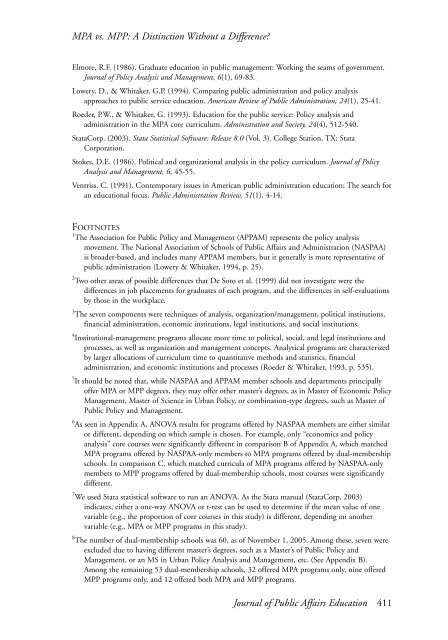JOURNAL OF PUBLIC AFFAIRS EDUCATION - National ...
JOURNAL OF PUBLIC AFFAIRS EDUCATION - National ...
JOURNAL OF PUBLIC AFFAIRS EDUCATION - National ...
Create successful ePaper yourself
Turn your PDF publications into a flip-book with our unique Google optimized e-Paper software.
MPA vs. MPP: A Distinction Without a Difference?<br />
Elmore, R.F. (1986). Graduate education in public management: Working the seams of government.<br />
Journal of Policy Analysis and Management, 6(1), 69-83.<br />
Lowery, D., & Whitaker, G.P. (1994). Comparing public administration and policy analysis<br />
approaches to public service education. American Review of Public Administration, 24(1), 25-41.<br />
Roeder, P.W., & Whitaker, G. (1993). Education for the public service: Policy analysis and<br />
administration in the MPA core curriculum. Administration and Society, 24(4), 512-540.<br />
StataCorp. (2003). Stata Statistical Software: Release 8.0 (Vol. 3). College Station, TX: Stata<br />
Corporation.<br />
Stokes, D.E. (1986). Political and organizational analysis in the policy curriculum. Journal of Policy<br />
Analysis and Management, 6, 45-55.<br />
Ventriss, C. (1991). Contemporary issues in American public administration education: The search for<br />
an educational focus. Public Administration Review, 51(1), 4-14.<br />
FOOTNOTES<br />
1 The Association for Public Policy and Management (APPAM) represents the policy analysis<br />
movement. The <strong>National</strong> Association of Schools of Public Affairs and Administration (NASPAA)<br />
is broader-based, and includes many APPAM members, but it generally is more representative of<br />
public administration (Lowery & Whitaker, 1994, p. 25).<br />
2<br />
Two other areas of possible differences that De Soto et al. (1999) did not investigate were the<br />
differences in job placements for graduates of each program, and the differences in self-evaluations<br />
by those in the workplace.<br />
3<br />
The seven components were techniques of analysis, organization/management, political institutions,<br />
financial administration, economic institutions, legal institutions, and social institutions.<br />
4<br />
Institutional-management programs allocate more time to political, social, and legal institutions and<br />
processes, as well as organization and management concepts. Analytical programs are characterized<br />
by larger allocations of curriculum time to quantitative methods and statistics, financial<br />
administration, and economic institutions and processes (Roeder & Whitaker, 1993, p. 535).<br />
5<br />
It should be noted that, while NASPAA and APPAM member schools and departments principally<br />
offer MPA or MPP degrees, they may offer other master’s degrees, as in Master of Economic Policy<br />
Management, Master of Science in Urban Policy, or combination-type degrees, such as Master of<br />
Public Policy and Management.<br />
6<br />
As seen in Appendix A, ANOVA results for programs offered by NASPAA members are either similar<br />
or different, depending on which sample is chosen. For example, only “economics and policy<br />
analysis” core courses were significantly different in comparison B of Appendix A, which matched<br />
MPA programs offered by NASPAA-only members to MPA programs offered by dual-membership<br />
schools. In comparison C, which matched curricula of MPA programs offered by NASPAA-only<br />
members to MPP programs offered by dual-membership schools, most courses were significantly<br />
different.<br />
7<br />
We used Stata statistical software to run an ANOVA. As the Stata manual (StataCorp, 2003)<br />
indicates, either a one-way ANOVA or t-test can be used to determine if the mean value of one<br />
variable (e.g., the proportion of core courses in this study) is different, depending on another<br />
variable (e.g., MPA or MPP programs in this study).<br />
8<br />
The number of dual-membership schools was 60, as of November 1, 2005. Among these, seven were<br />
excluded due to having different master’s degrees, such as a Master’s of Public Policy and<br />
Management, or an MS in Urban Policy Analysis and Management, etc. (See Appendix B).<br />
Among the remaining 53 dual-membership schools, 32 offered MPA programs only, nine offered<br />
MPP programs only, and 12 offered both MPA and MPP programs.<br />
Journal of Public Affairs Education 411

















